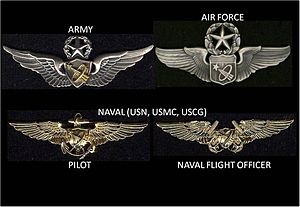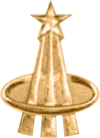- Astronaut Badge
-
Astronaut Badge 
Awarded by United States Type Badge Awarded for Completing training and traveling in a spaceflight, as defined by NASA or the United States Department of Defense. Status Currently awarded Statistics Last awarded On going Army Precedence Next (higher) (Group 2 badges)
CMB • EFMBEquivalent (Group 3 badges)
Astronaut • EOD • Aviator • Flight Surgeon • AircrewNext (lower) (Group 4 badges)
Parachutist • Air Assault • Military Freefall ParachutistRelated Aviator The Astronaut Badge is a badge of the United States, awarded to military and civilian pilots who have completed training and performed a successful spaceflight. A variation of the astronaut badge is also issued to civilians who are employed with the National Aeronautics and Space Administration as specialists on spaceflight missions.
Contents
Eligibility
To earn an astronaut badge, a military officer must complete all required training and participate in a space flight more than 100 kilometers (62 miles) above the Earth. This boundary, known as the Kármán line, comes from the Fédération Aéronautique Internationale and is a definition recognized by every country.[citation needed] However, in the 1960s, the United States Department of Defense awarded astronaut badges to military and civilian pilots who flew aircraft higher than 50 miles (80 kilometers).[1] Seven USAF and NASA pilots qualified for the astronaut badge by flying the sub-orbital X-15 rocket spaceplane.[1]
American test pilots Michael Melvill and Brian Binnie were each awarded a Commercial Astronaut Badge by the Federal Aviation Administration (FAA) when they flew sub-orbital missions aboard the Scaled Composites SpaceShipOne rocket spaceplane.[1] All other men and women awarded the astronaut badge earned it travelling to space in non-winged rockets, the X-15, or the space shuttle.
Military badges
Each of the military services issues its own version of the Astronaut Badge, which consists of a standard Aviation Badge with an Astronaut Device (shooting star through a halo) centered on the badge's shield, or escutcheon. The United States Army and Air Force Astronaut Badges are issued in three degrees: Basic, Senior, and Master/Command. The Senior Astronaut Badge is denoted by a star centered above the decoration, while the Master/Command level is indicated by a star and wreath.
United States Army
The gold Astronaut Device is issued by the U.S. Army to Army aviators, flight surgeons, and aircrew members that qualify as astronauts. The Astronaut Device has a gold shooting star and elliptical orbit which is affixed over the shield of previously awarded Army aviation badges. Army Astronauts that have yet to fly a mission and have not been awarded any aviation badge previously are awarded the Army Aviation Badge. Once they have flown a mission, they are awarded the Astronaut Device for their Army Aviation Badge. The shooting star and orbit representation is meant to imply the astronaut's theater of operations, space. The Army Astronaut Badge was approved on 17 May 1983. It is the rarest badge issued by the US Army.[2]
The Naval Astronaut insignias are issued in a single degree to naval aviators and flight officers from the United States Marine Corps, United States Navy, and United States Coast Guard, with all three branches being trained in the same pipeline. All three branches also wear the same insignia which consists of a Naval Aviator insignia or Naval Flight Officer insignia with a centered gold astronaut device. However, the Coast Guard only issues the Naval Flight Officer version of the astronaut insignia under the name "Coast Guard Astronaut insignia." [3]
United States Air Force
The U.S. Air Force Astronaut Badge consists of a standard USAF aeronautical badge upon which is centered the Astronaut Device. The Air Force does not consider Astronaut to be a separate rating from its six established rating badges, but as a "qualifier" to them, and may only be awarded by the Air Force Chief of Staff after written application upon completion of an operational space mission. The rating of Observer is used for USAF Mission Specialists who have completed training but not a mission and are not otherwise aeronautically rated as a USAF pilot or USAF navigator. In 2007, the U.S. Air Force announced the opening of astronaut mission specialists positions to enlisted personnel who met certain eligibility requirements with insignia based on the USAF Enlisted Aircrew Badge with superimposed Astronaut Device. No enlisted astronaut badges are yet known to have been issued.[4]
Civilian badges
NASA also has an Astronaut Badge, which is issued to civilian personnel who participate in U.S. space missions.[citation needed]
The U.S. Federal Aviation Administration has granted commercial astronaut wings to civilian pilots who have performed a successful spaceflight. Currently, only Mike Melvill and Brian Binnie have these wings.[5][6]
NASA Astronaut Pins
In addition to the Astronaut Badge, which is worn on a military uniform, an Astronaut Pin is also issued to all NASA astronauts. It is a lapel pin, worn on civilian clothing. The pin is issued in two grades, silver and gold, with the silver pin awarded to candidates who have successfully completed astronaut training and the gold pin to astronauts who have actually flown in space. Astronaut candidates are given silver pins but are required to purchase the gold pin at a cost of approximately $400.[7]
Apollo 12 astronaut Alan Bean took his silver pin to the Moon in November 1969 and left it on the lunar surface. He said later that since he had worn the silver pin for six years and that he would be wearing a gold pin after the mission, he would not be needing his silver one any more, so "what better place to leave it than on the moon?".[citation needed]
A unique astronaut pin was made for NASA astronaut Deke Slayton in 1967. It was gold in color, but instead of the star, it had a small diamond in its place. It was made at the request of the crew of the first manned mission of the Apollo program as a tribute to Slayton's work at NASA. The idea was that everyone in the Astronaut Office had thought that Slayton would never get to fly in space (due to his heart murmur; he would later fly on board the Apollo-Soyuz Test Project as Docking Module Pilot), but as they knew that it was primarily because of him that they managed to do so, he should wear a gold pin rather than a silver one as a token of appreciation. As they knew that Slayton would refuse to wear exactly the same gold pin as veteran astronauts, the diamond was substituted. The pin was supposed to have been flown on board the Apollo 1 spacecraft, then given to Slayton after the mission was over. However, the Apollo 1 crew died in a fire during a training exercise in January 1967. The pin was given to Slayton by the widows of the dead crew as a token of condolence. This diamond-studded gold pin was later flown to the moon on Apollo 11 in July 1969.[8]
See also
- Military badges of the United States
- Badges of the United States Air Force
- Badges of the United States Army
- Badges of the United States Coast Guard
- Badges of the United States Marine Corps
- Badges of the United States Navy
- Human spaceflight
- Edge of space
- Space tourism
- Spaceplane
References
- ^ a b c NASA (November 29, 2007). "Astronaut". World Book at NASA. NASA. http://www.nasa.gov/worldbook/astronaut_worldbook.html. Retrieved June 16, 2009.
- ^ "Army Astronaut Device and Badges", The Institute of Heraldry, Office of the Administrative Assistant to the Secretary of the Army, accessed March 18, 2009.
- ^ U.S. Coast Guard Uniform Regulations, COMDTINST M1020.6F
- ^ Astronaut Applications Open for Airmen
- ^ Active Commercial Space Licenses, FAA, accessed 2007-02-20
- ^ Schwartz, John (October 12, 2004). "Now Earning Wings, a New Kind of Astronaut". new York Times (The New York Times Company). http://www.nytimes.com/2004/10/12/science/space/12astr.html. Retrieved 16 July 2009.
- ^ Mullane, Mike (2006). Riding Rockets: The Outrageous Tales of a Space Shuttle Astronaut. Simon and Schuster. pp. 88. ISBN 0743296761.
- ^ Moon Shot by Deke Slayton
Special Skill Group 1 Special Skill Group 2 Special Skill Group 3 Special Skill Group 4 Special Skill Group 5 Marksmanship Identification National Guard and Other Categories:- United States military badges
Wikimedia Foundation. 2010.




